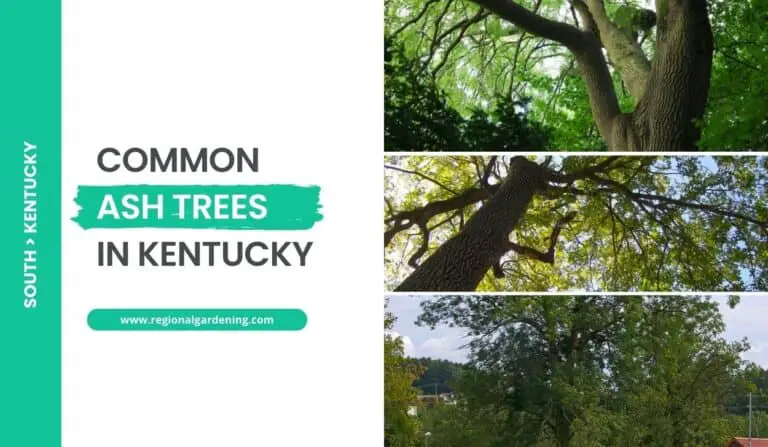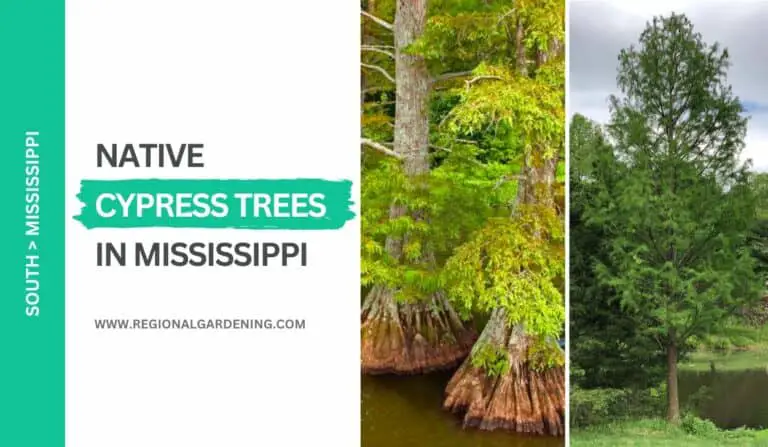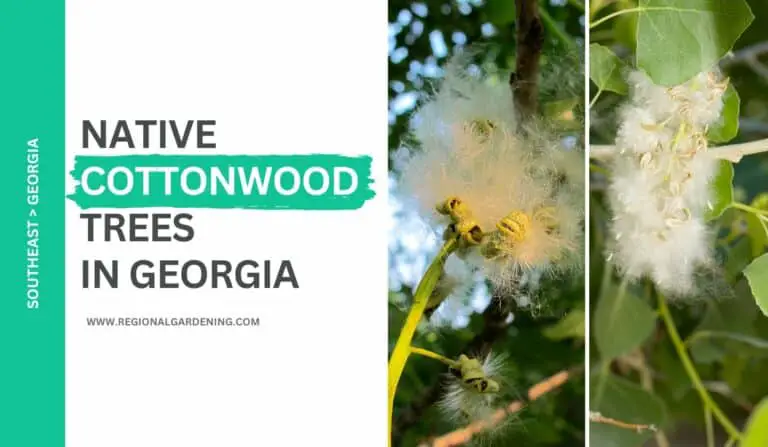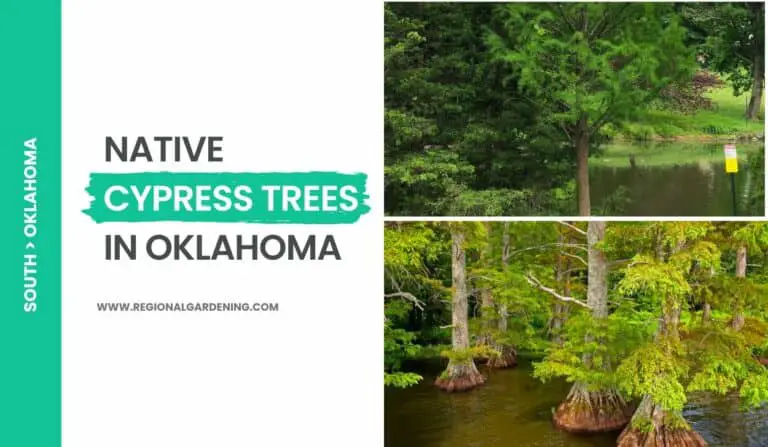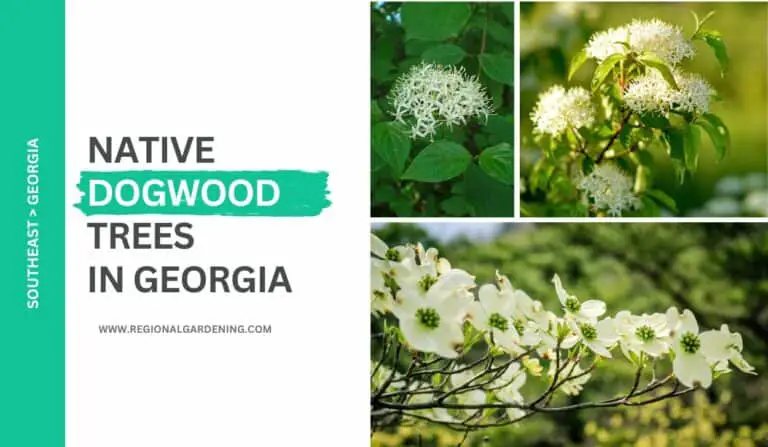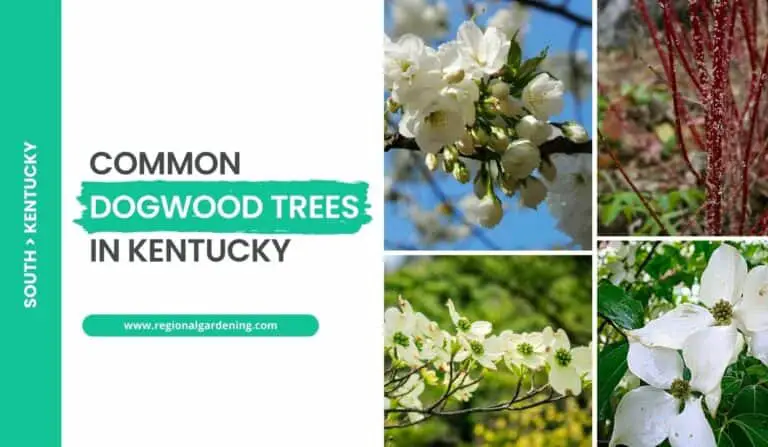9 Native Nut Trees In Mississippi (With Photos)
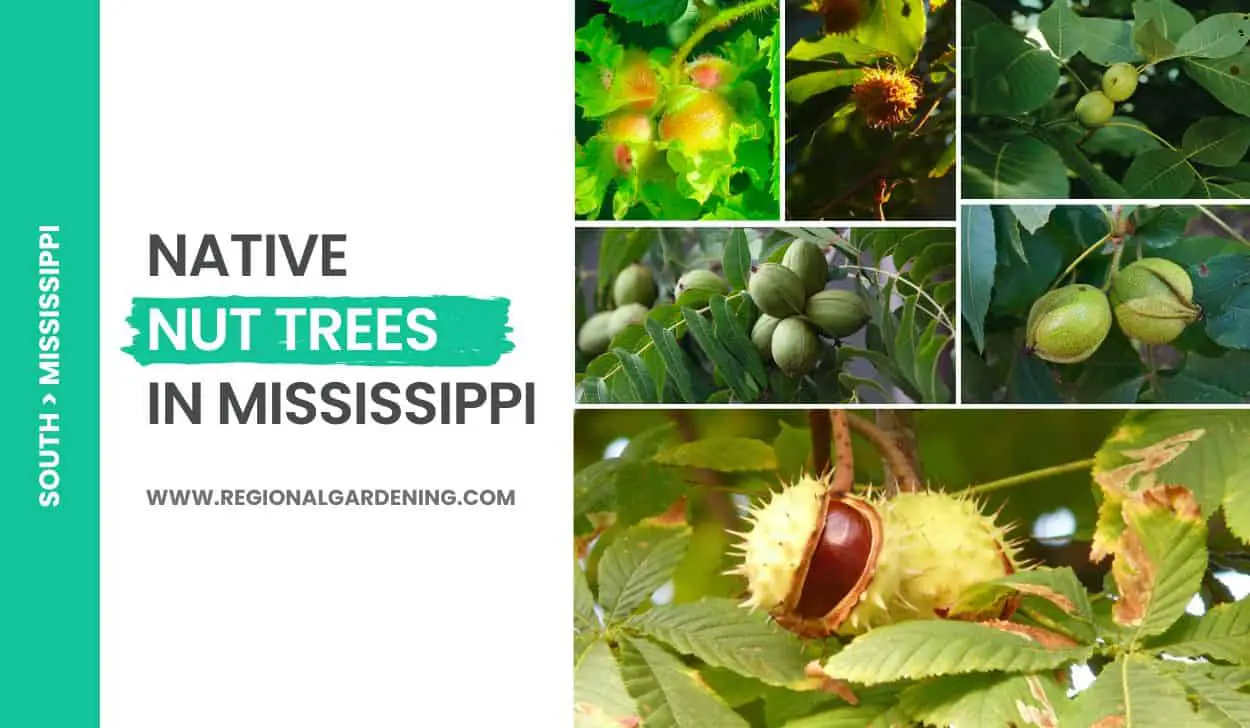
If you love to collect nuts and you are fortunate enough to live in Mississippi, you are in for a treat. This article will look at nine native nut trees in Mississippi.
With stunning images and detailed descriptions, you will be able to easily identify these valuable trees and potentially expand your nut-collecting hobby.
Mississippi’s varied climate and fertile soils provide ideal conditions for a wide range of nut trees to thrive. Mississippi is a nut lover’s paradise, with towering pecan trees and aromatic black walnuts.
So, without further ado, let’s dive in and discover the wonders of native nut trees in Mississippi.
1. Black Walnut
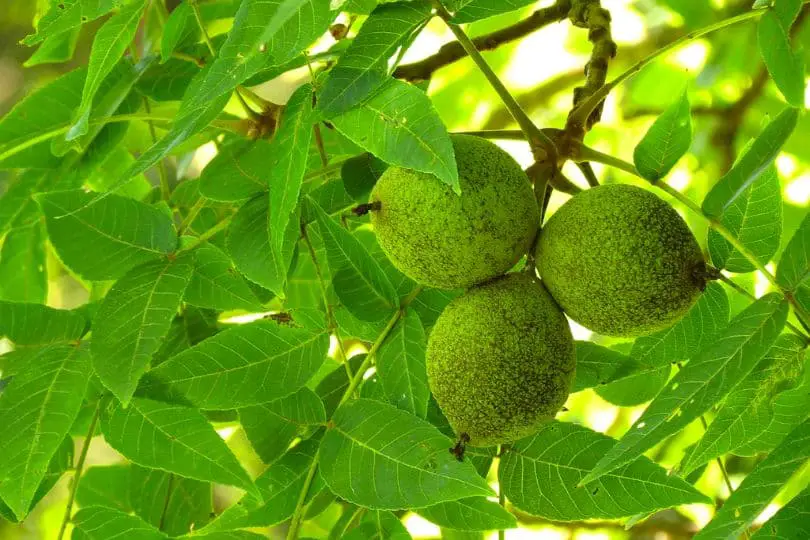
- Scientific Name: Juglans nigra L.
- Common Name(s): Black Walnut
- Mature Height: Up to 100 feet
- Native Range: From Massachusetts to Central Nebraska, south to Texas, and east to Georgia
- Fruits/Flowers: Nuts enclosed in a thick, succulent husk; monoecious flowers in stout catkins and 2- to 5-flowered spikes
- Uses: Edible nuts for squirrels, high timber value for furniture and cabinetry, used as gunstock material, landscaping (though it produces a toxin inhibiting the growth of other plants).
Juglans nigra L. (Black Walnut) is one of the tallest nut trees in Mississippi with odd-pinnately compound leaves. The ovate-lanceolate leaves are bright yellow-green in color and have coarsely serrated margins.
The tree yields sweet and edible nuts that are encased in a thick, luscious husk. The nuts are a dark brown tint. It has monoecious flowers that are staminate in sturdy catkins and pistillate in 2- to 5-flowered spikes.
Black Walnut is a fast-growing tree that can reach heights of 100 feet. It prefers moist, deep, and fertile soils, especially in low-lying areas and on mild slopes. It has a reasonable life expectancy of more than 50 years. The tree is shade-intolerant but may endure short periods of dryness. It is resistant to fire and does not develop in anaerobic settings.
Because of its premium timber, black walnut is a popular choice for solid and veneered furniture. Master artisans used the tree extensively over several times, including the Queen Anne, William and Mary, and Colonial periods. It was extensively employed as a gunstock material, particularly during the American Civil War and World Wars I and II.
Black Walnut offers nuts that are a key food source for squirrels in the wild. However, the tree is unappealing to other creatures as a source of food. It is sold commercially for landscaping, but its placement should be examined due to the production of “juglone,” a toxin that inhibits the growth of other plants around it.
2. Pecan
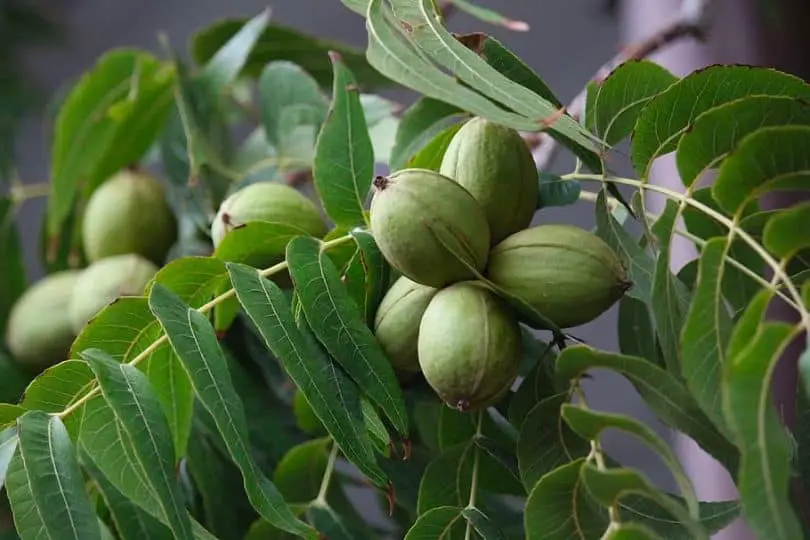
- Common name: Pecan
- Scientific name: Carya illinoensis
- Mature height: Up to 140 feet
- Native range: Lower Mississippi Valley, southwestern Indiana to southeastern Iowa, central Alabama to east and central Texas, southeastern Kansas, northeastern and central Mexico
- Flowers: The pecan tree produces green catkins and yellow, hairy spikes containing nuts with thin-skinned husks.
- Uses: Birds, squirrels, and other animals all eat the nuts, wood is used for furniture.
The pecan trees are by far the tallest nut trees in Mississippi that can reach a massive height of 140 feet.
It has pinnately complex leaves with 9-17 leaflets, which are dark yellowish green on top and paler green on the underside. The twigs are reddish brown, while the buds have valvate scales and are yellowish brown. The tree has green catkins and yellow, hairy spikes with thin-skinned husks on its nuts.
Pecan trees can be found across the lower Mississippi Valley, as well as other portions of the United States and Mexico. They require well-drained loam soils and can withstand pH levels ranging from 5.0 to 7.3. Birds, squirrels, and raccoons are just a few of the creatures that eat pecan tree nuts. The pecan tree’s wood is used to make furniture, cabinetry, and other goods.
Pecan trees are also cultivated for their edible fruit and for landscaping. However, due to pest and disease issues, they necessitate extensive maintenance. Native pecans were present in America before the arrival of the first immigrants, and they are currently used as sources for new types and as stock for selected clones.
3. American Chestnut
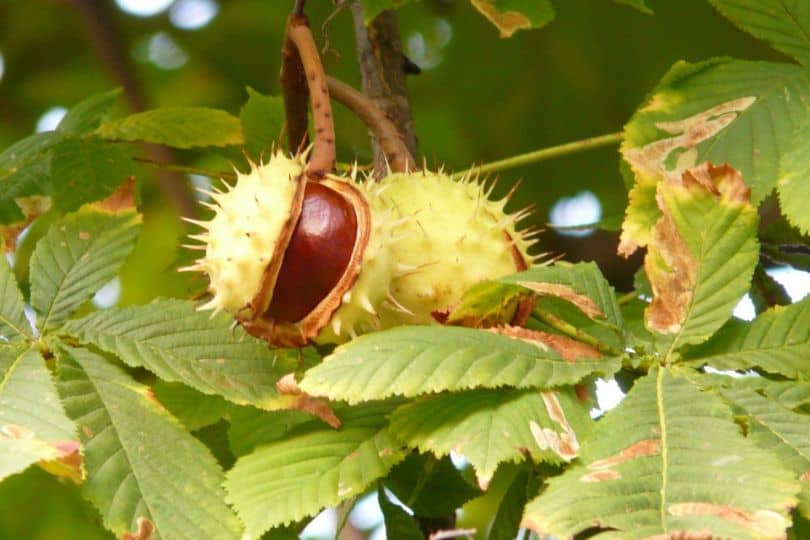
- Scientific Name: Castanea dentata (Marsh.) Borkh.
- Common Name(s): American Chestnut
- Mature Height: 115.0’
- Native Range: Michigan; through Iowa, Missouri, and Louisiana (skirting Arkansas), and all states east within the U.S.
- Flowers: Monoecious; unisexual; apetalous; staminate, in upright catkins, 6.0” – 8.0” long, green below the middle – red above.
- Uses: Timber
The American Chestnut, scientifically known as Castanea dentata (Marsh.) Borkh, is a deciduous tree with 7.0″-8.0″ long and 2.0″ wide alternating, simple leaves. The leaves are oblong-lanceolate in shape with coarsely serrated margins and a yellow-green tint above and a paler color below.
American Chestnut twigs are thin to somewhat stout, angular in shape, and reddish brown in color. The tree yields smooth, slightly compressed nuts that are encased in a 2-4-valved, leathery, spiny involucre.
The nuts are delicious and edible, measuring 0.5″-1.0″ in width. Flowers on the tree are monoecious, unisexual, and apetalous. The staminate flowers grow in erect catkins, while the pistillate flowers grow in clusters surrounded by bracts.
The American Chestnut is a huge tree that can grow to be 115.0′ tall. It has a fast growth rate and a lifespan of more than 100 years. The tree grows in lowlands as well as at elevations of over 4,000 feet and favors rich, well-drained soils. It is shade-intolerant and has a medium drought tolerance.
The American Chestnut was formerly the world’s best lumber-producing chestnut, accounting for up to 35% of forests in the eastern United States. It was widely employed for a variety of reasons, such as mine supports, telegraph poles, fences, and buildings. Because of its strength and adaptability, the wood was highly valued and was used in framing and veneer manufacture.
The American Chestnut populations, on the other hand, were badly impacted by a blight that spread in the early 1900s, decimating the trees. In certain regions, blight-killed trees are still being sold. As a once-dominant woodland tree, the American Chestnut has historical and ecological significance.
It is currently considered functionally extinct because to its sensitivity to the blight. Crossbreeding and genetic engineering are being used to create disease-resistant strains of the tree.
4. American Chinquapin
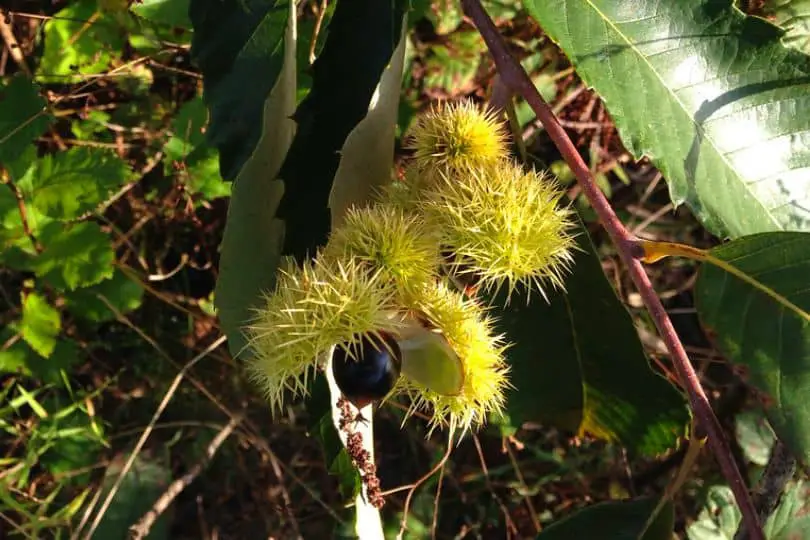
- Scientific Name: Castanea pumila (L.) Mill.
- Common Names: Allegheny Chinkapin, American chinquapin
- Mature Height: 14.0’ – 30.0’
- Native Range: New Jersey to West Virginia, west to Missouri and Oklahoma, south to Texas and Florida
- Fruits/Flowers: Nut enclosed in 2- to 3-valved involucre covered with sharp branched spines; flowers are monoecious, with staminate upright catkins and pistillate flowers.
- Uses: Nuts consumed by various wildlife including squirrels, chipmunks, and birds; wood used for fence posts and fuel; sometimes used for landscaping as a small ornamental tree or shrub.
The Allegheny Chinkapin (Castanea pumila (L.) Mill.), also known as the American chinquapin, is one of the tiny nut trees in Mississippi that grows to a mature height of 14.0′ – 30.0′.
Its range extends from New Jersey to West Virginia, west through Missouri and Oklahoma, and south to Texas and Florida.
This tree’s leaves are simple, alternating, and deciduous, measuring approximately 3.0″ – 5.0″ long and 1.5″ – 2.0″ broad. They are yellow-green on top and paler on the bottom, with a coarsely serrated edge and an oblong to elliptical shape. The twigs are slender, orange-brown, and hairy at first before turning glabrous. The buds are ovoid to oval in shape, 0.13″ long, and have a crimson tint and a pubescent surface.
The blooms are monoecious, which means they have staminate and pistillate flowers. The staminate flowers produce erect yellow catkins that are 4.0″ – 6.0″ long. In contrast, pistillate flowers are basal, rounder, and 1.2″ in diameter.
Furthermore, the tree produces silvery, tomentose bisexual catkins that are 3.0″ – 4.0″ long. The Allegheny Chinkapin’s fruit is a nut encased in a 2- to 3-valved involucre coated in sharp branching spines. The nut is ovoid in shape, measures around 0.75″ in length, and is a dark chestnut brown hue. The involucre, on the other hand, measures 1.0″ – 1.5″ in diameter.
The Allegheny Chinkapin thrives in a variety of habitats, including rich hillsides, dry sandy ridges, and swamp borders. It grows well in medium to coarse-textured soils with pH levels ranging from 4.5 to 7.5. Its growth rate is considered modest, with a maximum height of 14.0′ attainable in 20 years.
The tree has a short life expectancy, usually less than 50 years. Shade, drought resistance, and fire tolerance are among its tolerance levels. It cannot survive in anaerobic environments.
The Allegheny Chinkapin is valuable for both wildlife and human consumption. Animals that eat its nuts include squirrels, chipmunks, opossums, white-tailed deer, blue jays, and woodpeckers. White-tailed deer feed on the tree’s foliage.
The wood of the Allegheny Chinkapin is valued for its lightness, hardness, close grain, and strength. It is frequently used as a fence post and as fuel. The tree is sometimes used as a tiny ornamental tree or shrub in landscaping, with its lovely blossoms adding visual appeal.
5. American Hazelnut
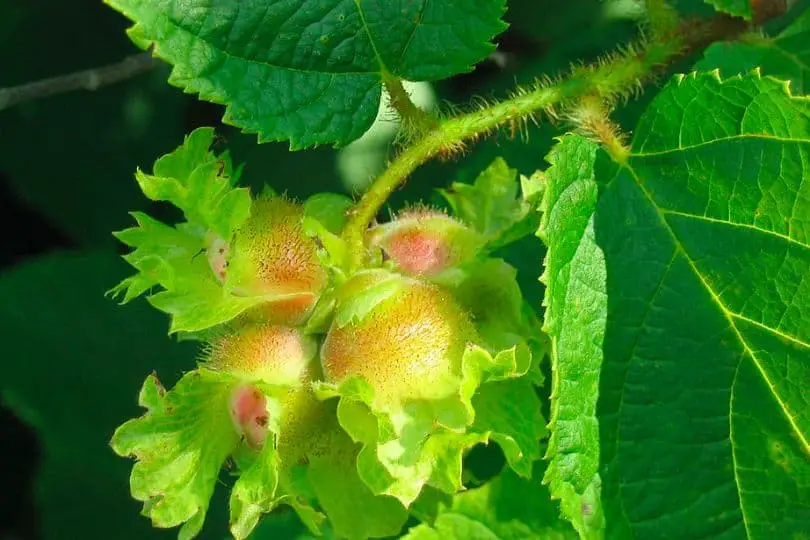
- Scientific Name: Corylus americana Walter
- Common Name(s): American Hazelnut, American filbert
- Mature Height: 10.0′
- Native Range: Eastern half of the U.S.
- Fruits/Flowers: Nut: edible, enclosed in two large downy, toothed bracts; Flower: monoecious, staminate catkins (light brown), pistillate flowers (white, inconspicuous)
- Uses: Wildlife food, ornamental.
The American Hazelnuts are another variety of small nut trees in Mississippi. It is also known as the American Filbert, is a deciduous shrub that can reach a height of 10.0 feet. It is indigenous to the eastern half of the United States, from Maine to North Dakota and south to Oklahoma, Arkansas, and Louisiana.
The tree produces delicious nuts that are enclosed in two enormous downy, serrated bracts, as well as small white flowers. The nuts are extremely nutritious and are eaten by a variety of wildlife species such as squirrels, foxes, turkeys, woodpeckers, and deer.
Rabbits, deer, and moose also consume the leaves, twigs, and catkins. Many wildlife species benefit from the American Hazelnut’s dense, low-growth habit, which provides cover and nesting locations.
The American Hazelnut is appreciated in landscaping for its ornamental appeal and is frequently planted in naturalized situations. Because of its colonial tendencies, it is especially suitable for boundaries. The shrub’s fall color is vivid scarlet or purple, adding to its aesthetic value. The plant is widely available from commercial producers, although there are no varieties other than the wild species.
While the American Hazelnut has little wood value, it plays an important ecological role in its native area. It prefers wet, chilly highland locations and grows best in fine to medium-textured soils with pH levels ranging from 5.0 to 7.0. It grows slowly and has a relatively short life span of less than 50 years. The American Hazelnut tolerates shade, drought, and fire reasonably well, but not anaerobic conditions.
6. American Beech
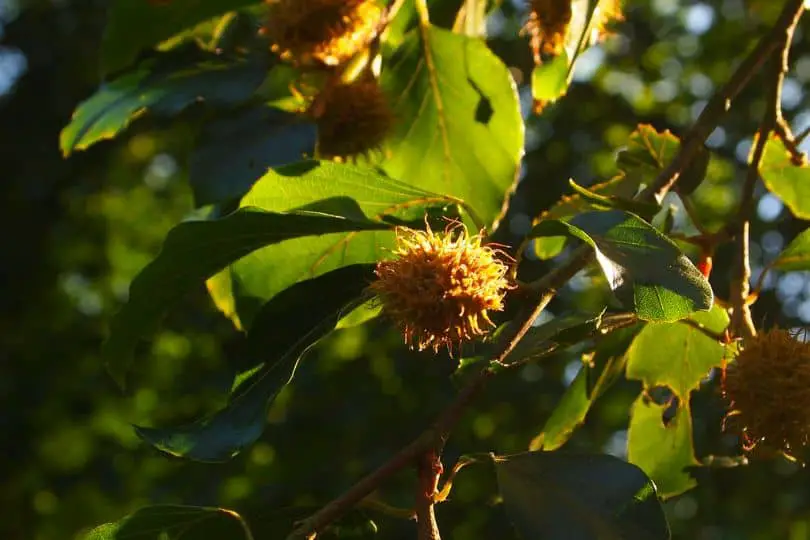
- Scientific Name: Fagus grandifolia Ehrh.
- Common Name(s): American Beech, Carolina Beech, Gray Beech, Red Beech, Ridge Beech, Stone Beech, White Beech, Winter Beech
- Mature Height: 95.0’
- Native Range: Northern Florida; west to eastern Texas; north to Wisconsin and southeastern Canada; in Mississippi, throughout
- Flowers: Monoecious, staminate on slender hairy stalks, in rounded heads, 1.0” dia., green; pistillate in 2- or 4-flowered spikes, pale yellow.
- Uses: Timber for flooring, furniture, veneer, plywood, and railroad ties; fuel wood for high density and good burning qualities.
The American Beech (Fagus grandifolia Ehrh.) is a deciduous tree with simple, alternating leaves. The leaves are oblong-ovate in form, dark green on top and yellow-green on the underside. The tree can reach a mature height of 95.0′ and is endemic to northern Florida, eastern Texas, Wisconsin, and southeastern Canada. It has monoecious blooms and nuts wrapped in a spiny bur.
Carolina Beech, Gray Beech, Red Beech, Ridge Beech, Stone Beech, White Beech, and Winter Beech are some of the popular names for the American Beech. It grows slowly and has a life span of more than 100 years. This tree tolerates shade and dryness well, yet it is extremely fire-resistant. It prefers rich mesic hardwood slopes, bottomlands, and swamp margins.
A number of birds and mammals feed on the American Beech, including mice, squirrels, chipmunks, black bears, deer, foxes, ruffed grouse, ducks, and bluejays. However, it has a low ranking for deer browsing. The tree also provides shelter for Carolina and black-capped chickadees.
The American Beech has valuable timber that is used for flooring, furniture, veneer, plywood, and railroad ties, among other things. Because of its great density and good burning properties, it is especially popular as fuel wood. This tree is used in the hardwood distillation business to make charcoal, wood alcohol, and lime acetate. It is also used in the manufacturing of pulp.
7. Bitternut Hickory
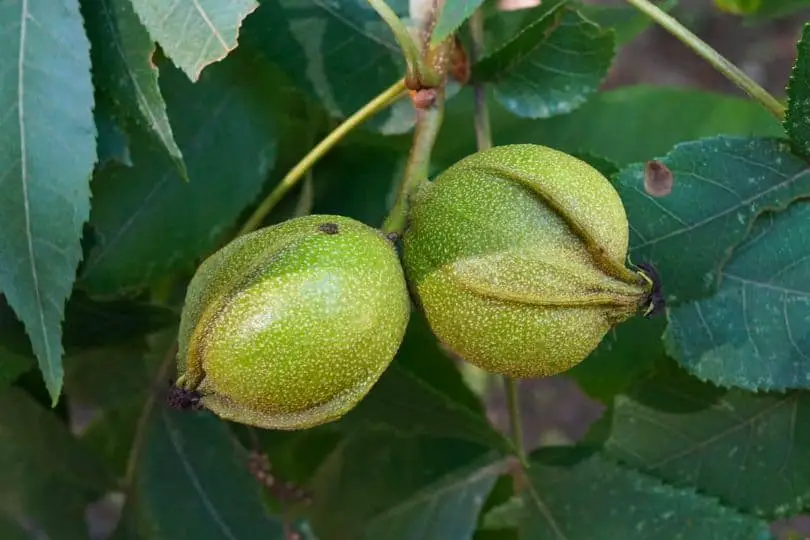
- Scientific name: Carya cordiformis (Wangenh.) K.
- Mature height: Up to 100 feet
- Native range: Southeastern Maine to central Minnesota; south to Florida; west through Kansas and Nebraska to eastern Texas
- Flowers: Yellowish pistillate catkins, green staminate catkins, globose reddish-brown nuts with a narrow wing
- Uses: Timber for tools, furniture, paneling, dowels, ladders, charcoal, and fuelwood; ornamental or shade tree; oil extracted from nuts used for oil lamps and as a cure for rheumatism
Bitternut Hickory is a large tree that can reach heights of 100 feet. Its leaves are pinnately complex, which means they have numerous leaflets on top and pale green underneath. The tree produces green staminate catkins and yellowish pistillate catkins. The nuts are globose, reddish-brown in color, and have a slender wing.
Bitternut Hickory trees thrive in damp environments such as valleys, slopes, and river bottoms. They can withstand a wide range of soil types and pH levels. The tree is also drought and fire resistant to moderate levels. It prefers to grow in the shadow and cannot live for long periods of time underwater.
The nuts produced by the Bitternut Hickory are normally not eaten by wildlife, though the bark may be consumed by the rare rabbit, beaver, or small rodent. The tree’s timber is also used to manufacture tools, furniture, paneling, dowels, ladders, charcoal, and fuelwood. Because of its thick lateral roots, it is also regarded a good species for safeguarding watersheds and restoring degraded lands.
Because of its decorative value and ability to maintain soil, the Bitternut Hickory is a popular tree for landscaping. It has a deep root system that aids in erosion prevention. Early settlers used the tree historically to collect oil from its nuts for use in oil lamps and as a rheumatism treatment.
8. Mockernut Hickory
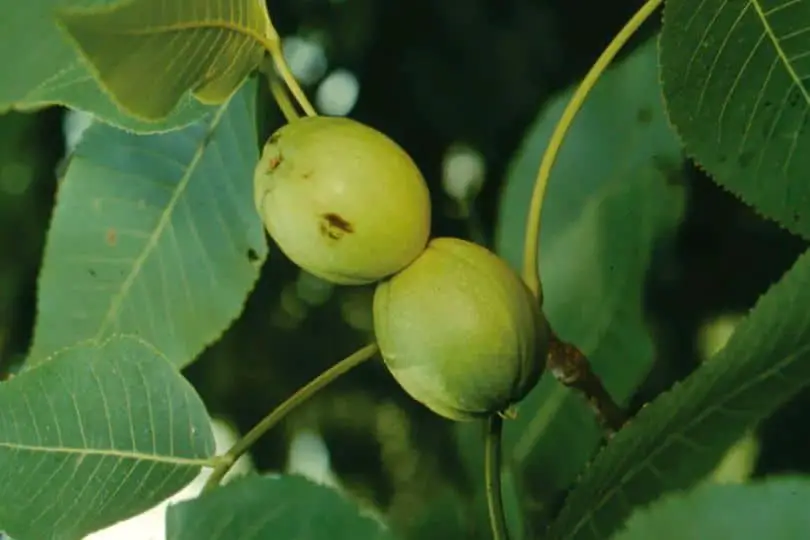
- Common Name: Mockernut Hickory
- Scientific Name: Carya tomentosa Nutt.
- Mature Height: 70.0 feet
- Native Range: Throughout North America
- Flowers: 2- to 5-flowered spikes with dark red stigmas.
- Uses: Wildlife food, timber of this tree is used for tool handles, agricultural implements, dowels, gymnasium equipment, poles, furniture, lumber, pulpwood, charcoal, and fuelwood.
Mockernut hickory, also known as white hickory, whiteheart hickory, bullnut, or hognut, is a tall tree with pinnately complex leaves ranging in length from 8.0 to 12.0 inches. The leaves have fine to coarsely serrated margins and are dark yellow-green on top and paler on the bottom. The tree’s twigs are sturdy, reddish-brown with hirsute, scaly surfaces. The buds are ovoid in shape and tan in hue.
Mockernut hickory fruit is a nut with a reddish-brown husk that is deeply 4-channeled. The nut is oblong-ellipsoidal and measures about 1.0 to 1.5 inches in length. Yellow staminate flowers appear in 3-branched catkins, and dark red pistillate flowers appear in 2- to 5-flowered spikes with scarlet stigmas.
Mockernut hickory can reach a height of 70.0 feet and grows slowly. It is found in the northern region on dry highland slopes, and in Alabama and Mississippi on sandy soils with shortleaf pine and loblolly pine. The tree enjoys deep, fertile soils and can withstand shade, drought, and fire.
Mockernut hickory is highly prized for its timber, which is utilized for a variety of applications including tool handles, furniture, lumber, and fuelwood. It is also a valuable food source for wildlife, with squirrels preferring the nuts and white-tailed deer browsing on them. The tree is an excellent shade tree with a deep taproot, but its slow growth rate is a disadvantage in landscaping.
9. Pignut Hickory

- Common Name: Pignut Hickory
- Scientific Name: Carya glabra (P.Mill.)
- Mature Height: 75.0 feet
- Native Range: Illinois, Missouri, Arkansas, Louisiana, Florida, Pennsylvania, New York, Vermont, Mississippi
- Flowers: Yellow catkins, small sweet nuts
- Uses: Nuts are food for various animals and the diverse uses of wood in making tools, furniture, and historically significant items.
The Pignut Hickory, also known as sweet pignut, coast pignut hickory, broom hickory, or smoothbark hickory, is a kind of tree that can reach heights of 75 feet. Its leaves are pinnately complex, which means they have several leaflets and are yellow-green on top and paler on the bottom.
The tree has sturdy reddish-brown twigs and ovoid to almost spherical buds. Squirrels, chipmunks, bears, and many birds enjoy the little sweet nuts produced by the Pignut Hickory.
The Pignut Hickory is typically found in the wild on upland slopes and ridges, but it can also grow in bottomland areas. This tree grows well in medium to fine-textured soils and can endure a wide variety of pH levels. It is shade-tolerant but not tolerant of wet or flooded situations. Pignut Hickories can live for more than 50 years and develop slowly.
The Pignut Hickory has several applications for people in addition to supplying food for wildlife. Because its wood is robust, resistant, and elastic, it is ideal for sporting items, agricultural tools, tool handles, and furniture. People utilized the tree to make broom handles, skis, wagon wheels, and even vehicle parts in the past.
Although the Pignut Hickory is not typically utilized in landscaping, it is drought-tolerant and adaptable to a wide range of soil conditions. When planted among evergreen oaks, it gives texture variation and has wonderful fall color, turning yellow. It also resists wind and frost damage.
Similar Articles
- Native Flowering Trees In Mississippi
- Common Fruit Trees In Mississippi
- Native Pine Trees In Mississippi
- Common Palm Trees In Mississippi
- Native Oak Trees In Mississippi
- Native Maple Trees In Mississippi
- Common Birch Trees In Mississippi
- Native Elm Trees In Mississippi
- Native Magnolia Trees In Mississippi
- Native White Flowering Trees In Mississippi
- Common Pink Flowering Trees In Mississippi
- Native Purple Trees In Mississippi
- Native Plum & Cherry Trees In Mississippi
- Native Ash Trees In Mississippi
- Native Cypress Trees In Mississippi
- Native Hickory Trees In Mississippi
Native Nut Trees In Mississippi – Sources
The Regional Gardening team makes sure that the information in our articles is accurate by only using sources that are known to be trustworthy. Some of these sources are peer-reviewed journals from government agencies, well-known universities, and scientific research organizations.
- Native Trees For Mississippi Landscapes, Mississippi State University Extension.
- Mississippi Trees, Publications Of Mississippi Forestry Commission.
- Department Of Plant & Soil Sciences, Mississippi State University Extension.
- Tree Care, Mississippi Urban Forest Council.


